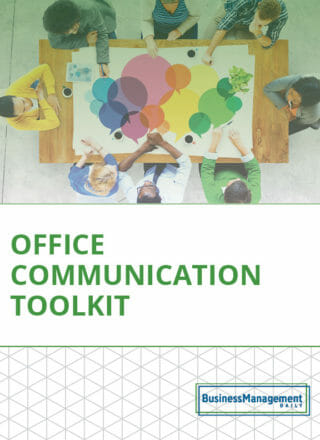Proper phone etiquette is still a necessity in business
While email may be the main form of communication for many businesses, phone calls are still a frequent necessity, especially when interacting with the public. However, phone etiquette is something that many employees at businesses seem to lack. Have you ever experienced any of the following scenarios?
-
You get a voice mail from someone unfamiliar. The person rushes and fails to speak clearly. You end up wasting time replaying the message over and over to decipher the caller’s number and name.
-
You place a call to the workplace of someone you met at a recent conference. The staff member who answers asks who you are. Upon providing your name and the title of your small business, she informs you that her boss is suddenly unavailable. You get the feeling you’re being brushed off.
-
You need to inquire about a product that has not arrived. You weren’t necessarily expecting the person on the other end of the line to provide a snap answer. However, what you encounter is someone who puts you on hold for so long that you wonder whether the phone call is dead.
Such situations prove frustrating and leave a bad taste in one’s mouth. Learning proper telephone etiquette is a must, even if you only make calls occasionally. For businesses that have frequent phone interactions, it’s vital that all employees are properly-versed in good etiquette.
Successful organizations prioritize customer experience. They aim to make a positive first impression and to continue demonstrating the importance of the individual client every time they interact. Sloppy communication skills, lack of respect for a customer’s time, and poor treatment cannot happen in the business world. Your image suffers, confidence in your services wanes, and people go elsewhere. The good news is that small changes can have a substantial impact. Whether you are the person placing the call or the one on the receiving end of the phone, take action to ensure clear, thoughtful, effective results.
Phone etiquette tips when answering calls
When it comes to business calls, do you know the importance of the number three? Experts often recommend that incoming calls to an office be answered within that amount of phone rings. This length allows time to compose oneself before picking up without making the caller start to get edgy that nobody is answering.
When you are out of the office or not taking calls due to a meeting or other uninterruptible situation, set voice mail to pick up even sooner than three rings. No sense in making callers sit through unnecessary rings when they can be delivered directly to the option to leave a message.
Work on making a positive impression from the get-go. As obvious as this sounds, always be conscious that the person on the other end cannot see you. Without the ability to witness facial expressions or body language, the caller will form judgments based on the tone of your voice and what you say. Be polite, informative, and helpful.
This advice holds true for call center reps, receptionists, office workers, and even managers. While each may tinker a bit with wording, an effective way to answer calls goes something like this: “Good morning. This is Anita with XYZ Industries. How may I assist you today?”
Why identify yourself and give the company name? It builds a personal connection. This act also assures the individual on the other end that he has reached the correct place.
Proper phone etiquette in sticky situations
As hard as one may try to make a phone call go as seamlessly as possible, problems sometimes occur. Here are suggestions for tackling three common problems:
The caller speeds through his name
First, be certain you are in a place without background noise and are giving the call your full attention. Then, politely ask the caller to repeat his name. If you still can’t catch it, say, “My apologies, but could you spell that please?” This tactic takes any tension out of the situation because you make it sound like it is your fault.
The boss wants you to screen calls and only let select ones through
As mentioned earlier, clients feel slighted if they get wind of a gatekeeper preventing their call from going through. Times do exist, though, when a leader needs to focus on other matters and must limit conversations to only the most important and urgent.
To avoid hurt feelings, create the impression that the boss is not available to anyone. Most of us work in companies where the standard practice is to ask, “Who’s calling?” But if you ask this question too early in the conversation, you imply to the caller that the boss might be available for some people but not for all. To avoid this implication, get into the habit of first announcing the unavailability, then asking for the caller’s name and message. If the caller ends up being someone approved to transfer through, you can then do so by saying, “Oh, one moment. Here he is.”
 You need to place someone on hold
You need to place someone on hold
No caller enjoys sitting around waiting for an answer. Thus, smart companies start with a proactive strategy: Educate those who routinely answer phone calls. They should know responses to frequently asked questions. They also should know the right person on staff to transfer someone to for specific issues so that customer calls do not get bounced around. To appear especially polite and helpful, use the word “connect” rather than “transfer.” It projects a vibe of direct action rather than raising suspicions of you trying to pass the buck.
The rules of phone etiquette say callers should not be kept on hold for longer than 20 seconds. If the call can’t be forwarded, the person answering the phone should offer to take a message or transfer the person to voice mail. If a verbal message is taken, ask for the caller’s full name, company affiliation, and phone number (unless absolutely certain you have the information from a previous call). Then, deliver the message promptly.
If you truly need to put the caller on hold, ask the person’s permission to do so. Resume the conversation within a minute, and thank the individual for holding. If further waiting proves necessary, explain the situation. Provide the choice to continue holding or to receive a return call. What you definitely want to avoid is a long wait time without any contact. The frustrated customer will wonder if the call has been forgotten or lost within the company’s phone system.
Voice mail etiquette
When used properly, voice mail enhances business operations. Leaving a message on a machine often proves far superior to leaving it with a person, especially if what needs conveying is lengthy or detailed. Valuable business time can be saved when you no longer need to play phone tag with a client and can provide information right away if she leaves her question on your voice mail. But don’t just slap together any old voice mail recording.
Enhance both communication and image by sticking to these guidelines:
-
Be brief. There is no reason that frequent callers (who probably are the most important to your company’s bottom line) should have to wait through a long message. Better yet, if your system has a feature that allows callers to push a button and be sent directly into voice mail, enable it and make the option prominent.
-
Likewise, some people still resent being relegated to voice mail systems, so always give callers the option of speaking to someone immediately.
-
Your outgoing message should include your full name and enough information so that first-time callers will know that they have reached the right person.
-
If you have unusual business hours, include them in your message.
-
In business voice mail, never include jokes, music, or other frivolous material.
Be equally conscientious when you are the one leaving a voice mail. State your name and phone number at the beginning and the end of the message. This repetition is important because the first time you say it, the recipient may not be ready with a pen and paper to take down your number. Also, taped messages can be hard to hear, especially when there are other distractions. Repeating your number twice allows for some error-checking. To increase efficiency, also provide some information about when and where you can be reached for a return call.
Additional phone etiquette tips
Finally, always remember the basics! Professionals worth their salt should already know the following, but here’s a refresher.
-
Give each call your full attention. Refrain from eating, reading, opening mail, or having side conversations with office colleagues. This concentration demonstrates respect for the person on the other end of the line, and it assists with catching what is being said.
-
Make and take phone calls in a quiet area. This setting helps both sides hear well and cuts down on interruptions and distractions. Be especially vigilant if using a speakerphone.
-
When you have a client or other visitor, accept only urgent telephone calls. A guest who is made to wait while his host takes several calls during a meeting may well conclude that his business is not important to the company.
-
When using a cellphone, remember it is not good etiquette to place or receive calls during a meeting, in a restaurant, or anywhere your conversation may bother others. Set phones to vibrate in these settings; do not turn on bells or beeps.
-
Be polite to everyone you call or who calls you. In the business world today, all relationships count. The most unlikely people may be able to help you in a way that makes a real difference.




